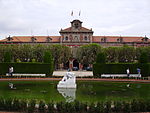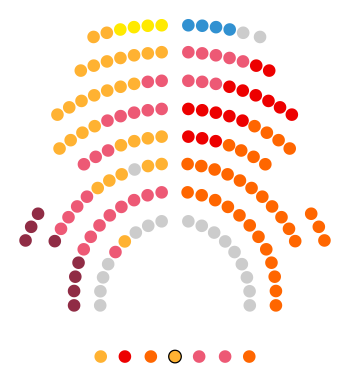Parliament of Catalonia
| logo | Parliament building |
|---|---|
|
|

|
| Basic data | |
| Seat: | Palau del Parlament de Catalunya, Parc de la Ciutadella , Barcelona |
| Legislative period : | 4 years |
| MPs: | 135 |
| Current legislative period | |
| Last choice: | December 21, 2017 |
| Chair: | Roger Torrent ( ERC ) |

|
|
| Distribution of seats: |
Government (66)
(2) Unionists (3) Reject unilateral independence process |
| Website | |
| www.parlament.cat | |
The Parliament of Catalonia ( Catalan Parlament de Catalunya , Spanish Parlamento de Cataluña ) is the regional parliament of the Spanish Autonomous Community of Catalonia , which drafts and decides laws, elects the President of the Generalitat de Catalunya and controls the government of Catalonia .
The Parliament building is located in the Parc de la Ciutadella in Barcelona .
history
The first representative and legislative bodies of Catalonia were the Assemblies de pau i treva (Peace and Armistice), the earliest mention of which is from 1027. These were originally ad hoc meetings at the local level convened by the clergy (Oliba, Bishop of Vic, who died in 1046, was a notable instigator but gradually became part of the court of the Counts of Barcelona). The first Catalan legal text, the Usatges de Barcelona, was promulgated by Count Ramon Berenguer I based on the resolutions of these assemblies.
Since 1978 Catalonia has had the status of an autonomous community within the Spanish state. As part of the democratic reforms in Spain, the first parliamentary elections in Catalonia took place on March 20, 1980 under the 1979 Statute of Autonomy . This first statute of autonomy was replaced in 2006 by a new version with expanded powers. Furthermore, a majority of the Catalan parties are striving for an extension of the autonomous powers. On November 9, 2015, Parliament passed a resolution on the secession from Spain (“Resolution on the start of the political process in Catalonia as a result of the election results of September 27, 2015”). Accordingly, the Catalans should be independent by 2017. 72 MPs voted in favor of the pro-independence proposal, 63 against. With a judgment of December 2, 2015, the Constitutional Court upheld a lawsuit and declared the parliamentary resolution of November 9, 2015 unconstitutional and null and void.
Electoral system
The Parliament of Catalonia consists of 135 members who are elected every four years in direct general elections. These are elected in four constituencies (the provinces): 85 in the Barcelona constituency , 17 in the Girona constituency , 15 in the Lleida constituency and 18 in the Tarragona constituency . In the D'Hondt procedure, mandates are assigned solely at the electoral district level. Only parties will be considered that have achieved at least three percent of the votes in the respective constituency. The allocation of seats to the four constituencies has remained unchanged since 1980 and even then did not follow pure proportional representation. In the 2012 election, around 47,500 people were eligible to vote in the province of Barcelona, 29,500 in the province of Girona, 20,900 in the province of Lleida and 30,900 in the province of Tarragona. Since the seats are distributed solely at electoral district level without compensation, this, in connection with the unequal ratio of eligible voters per seat, means that a majority in parliament is not necessarily associated with a majority of the total votes.
tasks
Parliament passes laws within the framework of the Statute of Autonomy . This regulates on the one hand the powers of the autonomous community vis-à-vis those of the Spanish state and on the other hand the interaction of the Catalan institutions, and is thus the functional equivalent of a constitution . Changes require the approval of the Catalan Parliament, the Spanish Parliament (in the form of an organic law ) and the Catalan population through a referendum .
Parliament elects the President of the Generalitat de Catalunya (President de la Generalitat de Catalunya) , who is the head of regional self-government. The President of the Generalitat can (Statute of Autonomy, Art. 67 No. 8) appoint a Conseller Primer (as much as Prime Minister ) and appoints the remaining consellers (as much as Ministerial ) who together make up the Consell Executiu or Govern de la Generalitat de Catalunya ( Regional government).
All the institutions of regional self-government together (parliament, president and government) form the Generalitat de Catalunya .
Web links
Individual evidence
- ↑ German-language text of the Statute of Autonomy on the pages of the Catalan Parliament ( memento of the original from April 11, 2009 in the Internet Archive ) Info: The archive link was inserted automatically and has not yet been checked. Please check the original and archive link according to the instructions and then remove this notice. (PDF; 504 kB).
- ↑ Resolució 1 / XI del Parlament de Catalunya, sobre l'inici del procés polític a Catalunya com a conseqüència delsresultats electorals del 27 de setembre de 2015. (PDF) Parliament of Catalonia, accessed on November 13, 2015 (Catalan).
- ^ Judgment of the Constitutional Court of December 2, 2015. (PDF) Spanish Constitutional Court, December 2, 2015, accessed on December 2, 2015 (Spanish).
Coordinates: 41 ° 23 ′ 17.2 " N , 2 ° 11 ′ 20.6" E
